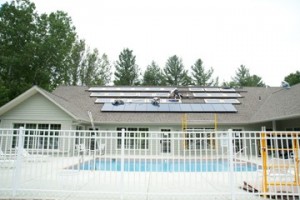Thinking Ahead at Ellison Bay’s Cottage Glen
- Share
- Tweet
- Pin
- Share
A Door County homeowners association is taking the long view on energy costs.
A crew from Appleton Solar installed 60, 235 watt solar panels on the roof of the recreation building at the Cottage Glen development in Ellison Bay July 11. The 1,200 square feet of panels will produce roughly 18,000 kWh of electricity per year, providing 12 to 15 percent of the recreation center’s energy needs.

Patrick and Ingrid Nahm, the owners of Appleton Solar, install 1,200 square feet of solar panels on the roof of the Cottage Glen recreation center in Ellison Bay.
While the up-front costs of solar power are still prohibitive, Cottage Glen Homeowners Association member Duane Kexel said the individual homeowners will see a return over the life of the system.
“This has a 25-year economic lifespan,” said Kexel, who bought a home at Cottage Glen in 2003 and recently retired from a career as an energy consultant. “Over the lifespan it will represent a 5 to 6 percent annual return on investment and save each of Cottage Glen’s 32 homeowners $2,000 to $3,000 in electricity costs.”
But Kexel said owners will realize other benefits as well. The insurable value of the recreation center increased by more than $75,000 due to the project, and Kexel said a new study on the impact of alternative energy on home sales suggests that units could sell for up to $2,400 more because of the installation. It will also keep 460 tons of CO2 emissions out of the atmosphere over the life of the project.
Peter Reddin, who developed Cottage Glen, praised the homeowners for their environmental commitment.
“Cottage Glen is home to an active group of residents who do not just give lip service to environmentalism, but put their efforts and dollars behind their convictions,” Reddin said.
The installation is the latest environmentally friendly step for a development known for its sensitivity to its surroundings. In 2004 it was the first condominium development in the county to gain the endorsement of Door Property Owners, an organization that promotes conservation efforts on the peninsula.
The development’s impervious surface ratio is under 20 percent in an area where zoning allows for 35 percent, and all of its utilities were buried, eliminating power lines and propane tanks on the property. It also includes a self-contained sewer and water system that cleans wastewater before releasing it into a 3.5-acre drain field of grass and wildflowers.
It was with this background in mind that Kexel spearheaded the solar project. He said the idea occurred to him as he was attending a homeowner’s association meeting and realized that the roof of the recreation center was pointing directly south, ideal for solar panels.
He began researching the idea of a roof-mounted solar system, but discovered that the project would cost $75,000 for a 14.1 kW system. Selling that price to his fellow homeowners would be tough, but he was able to work with Wisconsin Public Service to qualify for $48,000 in Focus On Energy grants, bringing the cost down to a much more digestible $27,000, plus about $5,000 in contingency funds. The total cost per member of the homeowners association is $1,000.
While price was important in getting the solar project done, Kexel said cost wasn’t everything to the homeowners.
“At least half of our owners wanted to do it for the environment, not the long-term payoff,” he said. “By the time we were done, 26 of our residents either approved or approved strongly of the project.”



